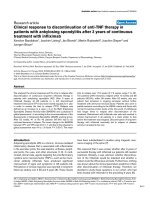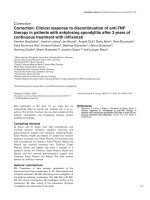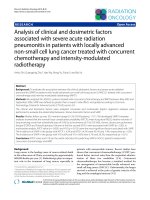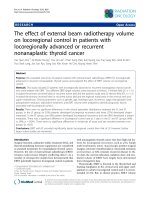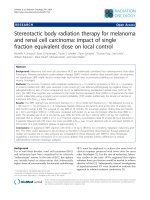Lymphocyte-sparing effect of stereotactic body radiation therapy compared to conventional fractionated radiation therapy in patients with locally advanced pancreatic cancer
Bạn đang xem bản rút gọn của tài liệu. Xem và tải ngay bản đầy đủ của tài liệu tại đây (2.21 MB, 8 trang )
Wu et al. BMC Cancer
(2019) 19:977
/>
RESEARCH ARTICLE
Open Access
Lymphocyte-sparing effect of stereotactic
body radiation therapy compared to
conventional fractionated radiation therapy
in patients with locally advanced
pancreatic cancer
Guangyin Wu1,2†, Michael J. Baine2†, Nan Zhao2, Sicong Li2, Xiaobo Li3,4* and Chi Lin2*
Abstract
Background: Conventionally fractionated (CF) radiation therapy (RT) has been associated with lymphopenia, leading
to compromised overall survival (OS) in cancer patients. It currently remains unknown if stereotactic body (SB) RT
induces lymphopenia to the same degree. The aim of this study is to determine if SBRT with either chemotherapy
(CMT) (Fluorouracil (5FU) or capecitabine) or Nelfinavir (NFV) to pancreatic adenocarcinoma induces lymphopenia to
the same degree as CFRT with 5FU or capecitabine and how any associated difference affects patient survival
outcomes.
Methods: Medical records of pancreatic adenocarcinoma patients treated with induction CMT followed by RT with
concurrent CMT or NFV were reviewed. Patients with total lymphocyte counts (TLCs) available both prior to and
following initiation of RT were included. Three groups were identified: CFRT/CMT, SBRT/CMT, and SBRT/NFV. Median
delivered RT doses for CFRT and SBRT were 50.4 Gy in 1.8 Gy fractions and 35 Gy in 7 Gy fractions, respectively. TLCs
from day 0 (the first day of RT) to 40 were recorded and analyzed using the Kruskal-Wallis test with p-values adjusted
with Bonferroni’s method. Linear regressions were utilized to estimate the slope of TLCs as it changes with time and
survival analysis was performed via Kaplan-Meier plots.
Results: One hundred patients were identified (28 CFRT/CMT, 27 SBRT/CMT, 45 SBRT/NFV). Median pre-RT TLCs were
not different among groups. Median lowest TLCs were significantly lower (p < 0.0001) and median TLCs reduction
over time were significantly greater (p < 0.0001) in the CFRT group than SBRT groups. There was no difference in
lowest TLCs or TLCs reduction over time between SBRT groups. Across all groups, the median time to lowest TLCs was
similar. Survival analysis revealed no significant difference in median OS between SBRT and CFRT groups. However, in
patients with surgery, Median OS for patients with SBRT/CMT was significantly higher than in those with SBRT/NFV
(p = 0.03).
Conclusions: Compared to CFRT, SBRT is associated with less lymphopenia. Further study of the effect of radiation
technique on immune status is warranted.
Keywords: Lymphocyte-sparing, SBRT, Pancreatic cancer
* Correspondence: ;
Guangyin Wu and Michael J. Baine are considered co-first-author
3
Department of Radiation Oncology, Fujian Medical University Union
Hospital, Fuzhou, Fujian, China
2
Department of Radiation Oncology, University of Nebraska Medical Center,
986861 Nebraska Medical Center, Omaha, NE 68198-68618, USA
Full list of author information is available at the end of the article
© The Author(s). 2019 Open Access This article is distributed under the terms of the Creative Commons Attribution 4.0
International License ( which permits unrestricted use, distribution, and
reproduction in any medium, provided you give appropriate credit to the original author(s) and the source, provide a link to
the Creative Commons license, and indicate if changes were made. The Creative Commons Public Domain Dedication waiver
( applies to the data made available in this article, unless otherwise stated.
Wu et al. BMC Cancer
(2019) 19:977
Background
Despite extensive research, adenocarcinoma of the pancreas remains one of the deadliest malignancies known
to man. It is estimated that 55,440 patients will be diagnosed with pancreas cancer in 2018 with more than 44,
000 ultimately succumbing to this disease [1]. With
moderate clinical advances, the average 5 year overall
survival rate of patients diagnosed with pancreas cancer
has more than doubled in the past 2 decades though remains low at 8.5% for all patients and 31.5% in patients
diagnosed with localized disease [2]. Unfortunately, more
than 90% of patients are diagnosed with disease that has
spread beyond the pancreas with more than half having
evidence of distant metastatic disease at the time of
diagnosis [2].
The role of radiation therapy in pancreatic adenocarcinoma remains somewhat controversial, though in the
United States is primarily utilized in the settings of
borderline-resectable or unresectable disease to provide
either down staging to allow for future resection or improved local control, respectively. Traditionally, radiation
therapy for the pancreas is provided to a relatively large
volume including the primary tumor and regional lymphatics and is delivered over the course of 25–30 treatments [3, 4]. Importantly, conventionally fractionated
radiation therapy (CFRT) is generally poorly tolerated
with common toxicities including anorexia, nausea/
vomiting, and diarrhea [5]. Additionally, past studies
have indicated that CFRT is associated with iatrogenic
lymphopenia [6, 7].
Reduction in total lymphocyte count (TLC) following
radiation therapy has been previously shown to exist
across multiple malignances including non-small cell
lung cancer, glioblastoma, and squamous cell carcinoma
of the head and neck with persistent association of
treatment-associated lymphopenia with poor patient outcomes [8–11]. Indeed, treatment-associated lymphopenia
has also been shown to reduce overall survival in patients
treated with adjuvant radiation therapy for resected pancreas cancer as well as definitive chemoradiotherapy for
patients with locally advanced disease [6, 7].
The etiology(s) underlying radiation-induced lymphopenia remain unclear. One proposed mechanism is that
repeated irradiation of blood vessels near or within the
treatment field allows the entire circulating blood pool
to ultimately encounter meaningful radiation doses, thus
damaging circulating lymphocytes as they flow through
the blood stream near the treatment site [12]. Another
proposed mechanism which has been studied specifically
in pancreas irradiation is that inadvertent dose delivered
to the spleen may account for the observed TLC reduction.7 Lastly, it is possible that treatment-induced lymphopenia is not directly related to the radiation
treatment but rather to the concurrent chemotherapy
Page 2 of 8
often delivered during treatments for all of the malignancies thus far associated with this phenomenon. This
latter mechanism is called into question, however, as if
concurrent chemotherapy, which is often provided at a
reduced dose, were to contribute significantly to
treatment-associated lymphopenia it would be expected
that full-dose induction chemotherapy would have similar effects though that was not shown to be the case in
patients with either non-small cell lung cancer or locally
advanced adenocarcinoma of the pancreas [7, 8].
Recently, the field of radiation oncology has started to
see a paradigm shift in the treatment of pancreatic cancer
with more clinics opting for short course stereotactic body
radiation (SBRT) techniques in which high-dose radiation
therapy is delivered over the course of 1–5 fractions [13].
Owing to the high dose per fraction delivered, treatment
volumes for SBRT are often substantially reduced as compared to their CFRT counterparts, frequently focusing on
the primary tumor alone. This technique is advantageous
as it offers more convenience for the patient and is generally associated with low rates of acute toxicities, due
mostly to the reduced treatment volumes. Importantly, it
has previously been described that SBRT techniques result
in significantly less treatment associated lymphopenia
than CFRT and that greater TLC reduction resulted in
worsened survival in patients treated with either radiation
technique [14]. Based on this data and the proposed
mechanisms for treatment induced lymphopenia, we
sought to validate the association of SBRT with reduced
treatment associated lymphopenia and determine if this
translated into improvement in survival based on radiation
technique. Further, we sought to further investigate the effects of systemic therapy delivered concurrent with radiation treatments on treatment-induced TLC reduction.
Methods
Patient selection
Medical records of patients with locally advanced pancreatic adenocarcinoma treated at the University of Nebraska
Medical Center (UNMC) with neoadjuvant or definitive
CFRT or SBRT following induction chemotherapy from
2004 to 2016 were retrospectively reviewed. In our study,
locally advanced pancreatic disease was defined as superior mesenteric artery and/or celiac axis tumor encasement
or superior mesenteric-portal vein confluence occlusion.
The following eligibility criteria were used to select the
study population: (1) > 19 years of age, (2) Eastern
Cooperative Oncology Group (ECOG) performance status ≤1, (3) biopsy-confirmed pancreatic adenocarcinoma,
(4) radiology-confirmed locally advanced disease, (5) no
previous abdominal irradiation, and (6) baseline (pre-radiation therapy) and follow-up complete blood counts
accessible through the Electronic Patient Record.
Wu et al. BMC Cancer
(2019) 19:977
As CFRT is commonly provided with concurrent systemic treatments but this practice is less consistent with
SBRT, there was significant concern that alterations in
concurrent treatment may ultimately confound analysis
of iatrogenic alterations in lymphocyte counts. In an attempt to account for this, included CFRT patients were
limited to those who received concurrent 5FU while
SBRT patients were treated with concurrent 5FU or
concurrent nelfinavir (an HIV protease inhibitor included in an institutional phase-I clinical trial as a potential radiation sensitizer). Through these groups, we
were able to compare CFRT and SBRT provided with
similar concurrent systemic therapy as well as various
concurrent systemic therapies provided with SBRT in
how each variable affects patient lymphocyte counts.
Treatment and total lymphocyte counts
CFRT patients underwent computed tomography (CT)
simulation in the supine position in custom-fitted
immobilization devices with oral and intravenous contrast agents. The clinical target volume included the
gross tumor volume plus regional lymphatic drainage
areas and was expanded from 1.5 to 2.5 cm to generate
the PTV. Radiation was delivered using either 3D conformal or intensity modulated techniques. The median
CFRT prescription dose was 50.4 Gy (range 8–50.4Gy)
at 1.8–2 Gy per fraction.
All SBRT patients underwent CT-guided implantation
of up to 2 MRI-compatible fiducials placed within or
near the pancreatic tumor. Patients underwent CT simulation in the supine position using custom-fitted
immobilization devices with oral and intravenous contrast agents and 4-dimensional (4D) assessment of
tumor motion. Median SBRT prescription dose was 35
Gy (range 25-40Gy) in 5 fractions.
Regardless of radiation technique, concurrent chemotherapy consisted of either 5FU administered by continuous infusion (2700 mg/m2/weekly) or capecitabine
(800–1000 mg/m2 twice daily) taken Monday through
Friday for a duration of between 30 and 39 days. SBRT
concurrent Nelfinavir was administered at 1250 mg PO
BID [15] for 3-5 weeks.
Total lymphocyte counts (TLCs) as available through
routine complete blood counts were recorded from immediately prior to radiation delivery to day 40 (with day
0 corresponding to the delivery of the first fraction of
radiation).
Page 3 of 8
were used for survival analysis. All statistical analysis was
performed using SPSS version 20.0 and SAS software.
Results
Patients
In total, 100 patients were identified who met the inclusion criteria for this study. Of these, 28 received CFRT
with concurrent chemotherapy (CFRT/CMT), 27 received SBRT with concurrent chemotherapy (SBRT/
CMT), and 45 received SBRT with concurrent NFV
(SBRT/NFV). Median age, gender distribution, tumor location, rates of subsequent resection, and baseline TLC
levels were similar across groups (Table 1). Additionally,
radiation doses were similar amongst the two groups receiving SBRT. Patients receiving CFRT/CMT tended to
be diagnosed with lower-stage disease than those who
underwent SBRT though stage at diagnosis was comparable between the two SBRT groups (Table 1).
Alteration of TLCs following treatment
Iatrogenic reduction in TLC levels was noted in patients
treated with CFRT/CMT, SBRT/CMT, and SBRT/NFV.
The greatest trend for reduction in TLCs was noted in
patients treated with CFRT/CMT (slope = (−)0.021) with
those treated with SBRT/CMT and SBRT/NFV having a
less pronounced TLC reductions (slope = (−)0.012 and
(−)0.008, respectively; p < 0.0001)) (Table 1, Fig. 1).
Similarly, the lowest median TLC values recorded
(95% confidence interval (CI)) following radiation were
significantly lower in the CFRT/CMT group (0.29 (0–
1.6)) than in the SBRT/CMT (0.74 (0.1–1.5)) or SBRT/
NFV (0.68 (0–1.6)) groups (p < 0.0001) (Table 1, Fig. 2).
Amongst the patients receiving SBRT, the lowest median
TLC values were not different regardless of concurrent
therapy (P = 1.000). The median time to realization of
the lowest TLC value recorded did not vary across
groups at 29, 25, 21 days, respectively (p = 0.281).
Overall survival
Statistical analysis
Survival from diagnosis did not significantly differ between
patients who received CFRT/CMT and those who were
treated with SBRT/CMT or SBRT/NFV with median
times to death (95% CI) of 9 (7–19) months, 14 (8–19)
months, and 14 (10–17) months, respectively (p = 0.495,
Fig. 3a). For those who underwent surgical resection following completion of radiation therapy, treatment with
SBRT/CMT was significantly associated with longer overall survival than SBRT/NFV (p = 0.030) and showed a
non-significant trend to improved survival compared to
those treated with CFRT/CMT (Fig. 3b).
Statistical comparisons were performed using the KruskalWallis test with p-values adjusted using the Bonferroni
method. Change in TLC levels over time were modeled
through linear regression analysis. Kaplan-Meier plots
Discussion
Similar to the previously published work by Wild et al.,
this current study indicates that SBRT for pancreas
Wu et al. BMC Cancer
(2019) 19:977
Page 4 of 8
Table 1 Clinical characteristics of the study population
Parameter
CFRT/chemo
28
SBRT/Chemo
27
SBRT/NFV
45
P2-valued
0.172a
Age (years)
Median (range)
P1-valued
61 (49–76)
66 (43–96)
62 (34–79)
0.197 b
Gender
male
12 (43%)
15 (56%)
29 (64%)
female
16 (57%)
12 (44%)
16 (36%)
0.080 b
Tumor location
Head/neck
25 (89%)
21 (78%)
43 (96%)
Body/tail
3 (11%)
6 (22%)
2 (4%)
0.029b
Tumor Stage
IIA
16 (57%)
9 (33%)
14 (31%)
IIB
4 (14%)
11 (41%)
13 (29%)
III
8 (29%)
5 (19%)
18 (40%)
IV
0 (0%)
2 (7%)
0
yes
9 (32%)
10 (37%)
13 (29%)
no
19 (68%)
17 (63%)
32 (71%)
5FU or Capecitabine
28 (100%)
27 (100%)
0
Nelfinavir
0
0
45 (100%)
5GY*5
6 (22%)
8 (18%)
6GY*5
4 (15%)
3 (7%)
7GY*5
17 (63%)
9 (20%)
8GY*5
0
25 (55%)
0.088b
Subsequent Resection
0.763 b
Chemotherapy
Dose/fractionation
1.8Gy*13 = 23.4Gy
1 (3.6%)
1.8Gy*17 = 30.6Gy
1 (3.6%)
1.8Gy*28 = 50.4Gy
20 (71.4%)
2.0Gy*4 = 8Gy
1 (3.6%)
2.0Gy*25 = 50Gy
4 (14.2%)
2.5Gy*17 = 42.5Gy
1 (3.6%)
Baseline TCLs (X 103/µl)
Median (range)
0.740 a
1.48 (0.5–2.8)
1.43 (0.4–3.3)
1.38 (0.3–2.6)
Lowest TCLs (X 103/µl)
Median (range)
< 0.0001 c
0.29 (0–1.6)
0.74 (0.1–1.5)
0.68 (0–1.6)
0.281 c
Days to Lowest TCLs
Median (range)
29 (13–38)
25 (0–40)
21 (0–40)
Slope of TCLs Change (X 103/µl per day)
Median (range)
a
1.000c
< 0.0001c
−0.021 (−0.05–0.02)
P was calculated from an ANOVA test Bonferroni adjustment;
b
P was calculated from a Chi2 test or an Exact test;
c
P was calculated from a Kruskal-Wallis test with Bonferroni adjustment;
d
P1 for three sample comparisons and P2 for two SBRT sample comparisons
−0.012 (−0.09–0.01)
−0.008 (−0.03–0.04)
0.242c
Wu et al. BMC Cancer
(2019) 19:977
Page 5 of 8
Fig. 1 Median (95% CI) TLCs reduction over time in patients treated with CFRT/CMT (Blue), SBRT/CMT (orange), and SBRT/NFV (gray)
Fig. 2 a Median (95% CI) pre-RT baseline TLCs (X 103/µl), b Slope of median (95% CI) TLCs reduction over time (X 103/µl per day), c Median (95%
CI) lowest TLCs (X 103/µl), and d Median (95% CI) time to lowest TLCs (days) in patients treated with CFRT/CMT, SBRT/CMT, and SBRT/NFV
Wu et al. BMC Cancer
(2019) 19:977
Page 6 of 8
Fig. 3 a Overall survival curves for patients treated with CFRT/CMT (Blue), SBRT/CMT (Red), and SBRT/NFV (Green), b Overall survival curves for
patients treated with surgical resection following CFRT/CMT (Blue), SBRT/CMT (Red), and SBRT/NFV (Green)
adenocarcinoma is associated with significantly less
treatment-associated lymphopenia than CFRT, regardless of if the patient received any concurrent systemic
therapy [14]. These results coincide well with the proposed mechanisms for treatment-induced lymphopenia
resulting from dose to the blood-pool and/or spleen as
the reduced treatment volume in SBRT would result in
less dose to the spleen and great vessels and the reduction in fraction number would reduce the total volume
of blood exposed to radiation over the treatment course
Wu et al. BMC Cancer
(2019) 19:977
[7, 12]. Importantly, though, treatment with SBRT regimens did not fully prevent the post-treatment down
trending of TLCs in the 40 days following radiation
treatment as both SBRT groups studied also showed
negative TLC slopes on serial blood counts following
treatment. This data suggests that radiation-induced
lymphopenia cannot be fully abated through the reduction of treatment volume and fraction number as provided by stereotactic techniques.
Interestingly, in contrast to previously published reports the greater degree of treatment-induced lymphopenia observed in patients undergoing CFRT did not
translate into a significant reduction in overall survival.
The trend toward decreased survival in SBRT patients
treated with concurrent NFV as compared to concurrent
chemotherapy despite similar post-radiation TLC reductions suggests that this difference is irrespective of iatrogenic alterations in lymphocyte counts. Additionally, the
subjective difference between overall survivals between
the SBRT groups insinuates that NFV either does not
confer clinically relevant radiosensitization or that the
effect of radiosensitizing doses of 5-fluorouracil provides
further benefit outside of improving radiation efficacy.
Importantly, the overall survivals reported in this study
are similar to those published by other groups previously, further validating our data [6, 14].
Despite the lack of statistical significance in the overall
survival analysis, the presented data remain important in
both the field of radiation oncology and in the general
treatment of pancreatic adenocarcinoma. This analysis
further bolsters the trend toward increased utilization of
SBRT for pancreas cancer as this modern technique appears to reduce the likelihood of the thus far poorly
understood though likely important acute/subacute toxicity of treatment associated lymphopenia. Further, this
data continues to suggest that, while radiation therapy is
considered a focal treatment technique resulting in toxicity within the treatment field alone, the effects of radiation therapy can be systemic and radiation treatment
volumes may need to be adjusted to account for this.
Our data suggests that such volume reduction through
SBRT indeed will reduce this systemic toxicity. With further study into this phenomenon of treatment associated
lymphopenia as well as the current ongoing research investigating the utility of immunotherapy and pancreatic
adenocarcinoma, it is also probable that this data will
become increasingly important in the near future as induction of lymphopenia through radiation therapy will
likely significantly reduce the immune system’s ability to
be utilized in the treatment of this disease [16].
We acknowledge that this study comes with multiple
limitations. Specifically, the retrospective nature of this
analysis increases the likelihood for the presence of
unaccounted for confounding factors which limited
Page 7 of 8
interpretation of the data. Further, despite the reasonable number of patients included in the study as a
whole, each treatment group analyzed individually had
low patient numbers, reducing the power necessary for
more robust analysis and further increasing the potential
for false positive/negative results. Additionally, while
long-term lymphopenia has been shown in cancer patients, and that long term lymphopenia has been associated with higher mortality after chemoradiation therapy
in multiple studies [6, 17, 18], our data set was truncated
at 40 days post radiation therapy. Due to the continued
downward trend noted in our linear regression analysis
across all patient groups, it is quite possible that the difference in treatment associated lymphopenia may be
greater with increased elapsed time and thus provide
greater statistical significance. Unfortunately, due to
multiple factors including patients being treated with
further chemotherapy of different regimens after 40 days,
patients being lost to follow-up, patients being treated
by outside medical oncologists, and the general poor
prognosis of this disease, radiation-associated TLC data
could not be reliably obtained in our patient population
past this 40 day period. Therefore, we are not able to
address the survival impact of radiation (with chemotherapy or nelfinavir)-induced long term lymphopenia in
our cohort. This is a major limitation of this study.
Lastly, treatment volumes prescribed for each SBRT patient that were not described in this data set may significantly affect the associated toxicities, including
treatment associated lymphopenia. The effect of this
confounding variable may be limited as all patients included in the study were treated by a single radiation
oncologist (Chi Lin), though the lack of a standardized
approach for SBRT treatment volumes in this setting undeniably increases this potential.
Conclusion
Our data suggests that SBRT is associated with a significant reduction in treatment-induced lymphopenia when
compared to CFRT but, in contrast to previously published work, this did not translate to a survival benefit
associated with the more modern technique. Interestingly, the combination of chemotherapy with SBRT is
associated with improved overall survival in patients
who go on to receive a resection when compared to
SBRT in combination with Nelfinavir, suggesting that
this may be a superior treatment regimen in this selected
patient population. We believe that this data, in combination with data previously reported by other groups,
warrants further validation in a prospective manner as
well as provides evidence for a potentially significant
confounding variable which should be taken into the account in current and future immunotherapy studies.
Wu et al. BMC Cancer
(2019) 19:977
Abbreviations
4D: 4-dimensional; 5FU: Fluorouracil; CF: Conventionally fractionated;
Cl: Confidence interval; CMT: Chemotherapy; ECOG: Eastern Cooperative
Oncology Group; NFV: Nelfinavir; OS: Overall survival; RT: Radiation therapy;
SB: Stereotactic body; TLC: Total lymphocyte count; UNMC: University of
Nebraska Medical Center
Page 8 of 8
7.
8.
9.
Acknowledgements
The authors acknowledge Amy Filler-Katz for her efforts in the preparation of
IRB application.
Authors’ contributions
GW, XL and CL conceived and designed the study. GW, MJB, NZ, SL, XL and
CL contributed with clinical data acquisition, analysis and interpretation. GW,
NZ and CL performed the statistical analysis. GW, and MJB and CL wrote and
edited the manuscript. All authors read and approved the final version of the
manuscript.
Funding
This study is partially supported by DHHS/NIH/NCI 2 P50 CA127297-06A1
(Hollingsworth). The funding bodies had no role on the design, data collection, analysis and manuscript writing of this study.
Availability of data and materials
The datasets used and/or analyzed during the current study are available
from the corresponding author on reasonable request.
10.
11.
12.
13.
14.
15.
Ethics approval and consent to participate
UNMC Institutional Review Board approved the study (IRB#050–17-EP). The
need for informed consent has been waived by UNMC Institutional Review
Board.
Consent for publication
Not applicable.
16.
17.
Chadha AS, Liu G, Chen HC, et al. Does unintentional splenic radiation
predict outcomes after pancreatic Cancer radiation therapy? Int J Radiat
Oncol Biol Phys. 2017;97(2):323–32.
Campian JL, Ye X, Brock M, Grossman SA. Treatment-related
lymphopenia in patients with stage III non-small-cell lung cancer.
Cancer Investig. 2013;31(3):183–8.
Yovino S, Grossman SA. Severity, etiology and possible consequences of
treatment-related lymphopenia in patients with newly diagnosed highgrade gliomas. CNS Oncol. 2012;1(2):149–54.
Mendez JS, Govindan A, Leong J, Gao F, Huang J, Campian JL.
Association between treatment-related lymphopenia and overall survival
in elderly patients with newly diagnosed glioblastoma. J Neuro-Oncol.
2016;127(2):329–35.
Campian JL, Sarai G, Marur S, Grossman SA. Association between severe
treatment-related lymphopenia and progression-free survival in patients
with newly diagnosed squamous cell head and neck cancer. Head Neck.
2014;36(12):1747–53.
Yovino S, Kleinberg L, Grossman SA, Narayanan M, Ford E. The etiology of
treatment-related lymphopenia in patients with malignant gliomas:
modeling radiation dose to circulating lymphocytes explains clinical
observations and suggests methods of modifying the impact of radiation
on immune cells. Cancer Investig. 2013;31(2):140–4.
Trakul N, Koong AC, Chang DT. Stereotactic body radiotherapy in the
treatment of pancreatic cancer. Semin Radiat Oncol. 2014;24(2):140–7.
Wild AT, Herman JM, Dholakia AS, et al. Lymphocyte-sparing effect of
stereotactic body radiation therapy in patients with Unresectable pancreatic
Cancer. Int J Radiat Oncol Biol Phys. 2016;94(3):571–9.
Brunner TB, Geiger M, Grabenbauer GG, et al. Phase I trial of the Himan
immunodeficiency virus protease inhibitor Nelfinavir and Chemoradiation
for locally advanced pancreatic Cancer. J Clin Oncol. 2008;16:2699–706.
Thind K, Padrnos LJ, Ramanathan RK, Borad MJ. Immunotherapy in
pancreatic cancer treatment; a new frontier. Ther Adv Gastroenterol.
2017;10(1):168–94.
Grossman SA, Ellsworth S, Campian J, Wild AT, Herman JM, Laheru D, Brock
M, Balmanoukian A, Ye X. Survival in patients with severe Lymphopenia
following treatment with radiation and chemotherapy for newly diagnosed
solid tumors. J Natl Compr Cancer Netw. 2015;13(10):1225–31.
Wu ES, Oduyebo T, Cobba LP, Cholakiana D, Kongb X, Fadera AN, Levinsona
KL, Tanner AEJ III, Stonea RL, Piotrowskic A, Grossmanc S, Roche KL.
Lymphopenia and its association with survival in patients with locally
advanced cervical cancer. Gynecol Oncol. 2016;140(1):76–82.
Competing interests
The authors declare that they have no competing interests.
18.
Author details
1
Department of Radiation Oncology, Henan Provincial People’s Hospital;
People’s Hospital of Zhengzhou University, Henan, China. 2Department of
Radiation Oncology, University of Nebraska Medical Center, 986861 Nebraska
Medical Center, Omaha, NE 68198-68618, USA. 3Department of Radiation
Oncology, Fujian Medical University Union Hospital, Fuzhou, Fujian, China.
4
College of Medical Technology and Engineering, Fujian Medical University,
Fuzhou, Fujian, China.
Publisher’s Note
Received: 4 January 2019 Accepted: 30 September 2019
References
1. American Cancer Society. Cancer Facts & Figures 2018. Atlanta: American
Cancer Society; 2018.
2. Fast Stats: An interactive tool for access to SEER cancer statistics.
Surveillance Research Program, National Cancer Institute. cer.
gov/faststats. Accessed 14 Aug 2017.
3. Regine WF, Winter KA, Abrams R, et al. Fluorouracil based Chemoradiation
with either gemcitabine or fluorouracil chemotherapy following resection of
pancreatic adenocarcinoma: 5-year analysis of the US intergroup/RTOG
9704 phase III trial. Ann Surg Oncol. 2011;18(5):1319–26.
4. Van Laethem J, Hammel P, Mornex F, et al. Adjuvant gemcitabine alone
versus gemcitabine-based chemoradiotherapy after curative resection for
pancreatic cancer: a randomized EORTC-40013-22012/FFCD-9203/GERCOR
phase II study. J Clin Oncol. 2010;28(29):4450–6.
5. Willett CG, Czito BG, Bendell JC, Ryan DP. Locally advanced pancreatic
Cancer. J Clin Oncol. 2005;23(20):4538–44.
6. Balmanoukian A, Ye X, Herman J, Leheru D, Grossman SA. The association
between treatment-related lymphopenia and survival in newly diagnosed
patients with resected adenocarcinoma of the pancreas. Cancer Investig.
2012;30(8):571–6.
Springer Nature remains neutral with regard to jurisdictional claims in
published maps and institutional affiliations.

